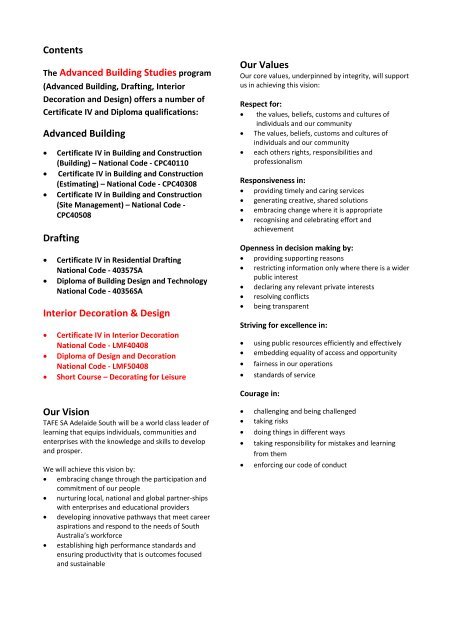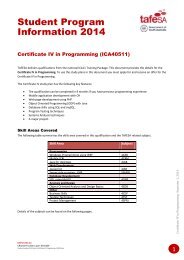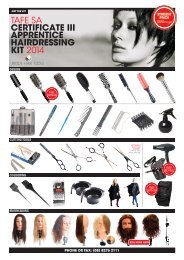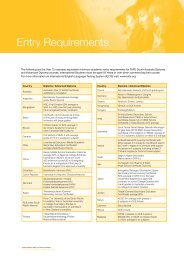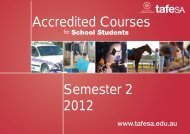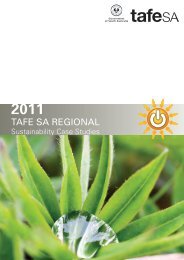Contents The Advanced Building Studies program ... - TAFE SA
Contents The Advanced Building Studies program ... - TAFE SA
Contents The Advanced Building Studies program ... - TAFE SA
Create successful ePaper yourself
Turn your PDF publications into a flip-book with our unique Google optimized e-Paper software.
<strong>Contents</strong><br />
<strong>The</strong> <strong>Advanced</strong> <strong>Building</strong> <strong>Studies</strong> <strong>program</strong><br />
(<strong>Advanced</strong> <strong>Building</strong>, Drafting, Interior<br />
Decoration and Design) offers a number of<br />
Certificate IV and Diploma qualifications:<br />
<strong>Advanced</strong> <strong>Building</strong><br />
� Certificate IV in <strong>Building</strong> and Construction<br />
(<strong>Building</strong>) – National Code - CPC40110<br />
� Certificate IV in <strong>Building</strong> and Construction<br />
(Estimating) – National Code - CPC40308<br />
� Certificate IV in <strong>Building</strong> and Construction<br />
(Site Management) – National Code -<br />
CPC40508<br />
Drafting<br />
� Certificate IV in Residential Drafting<br />
National Code - 40357<strong>SA</strong><br />
� Diploma of <strong>Building</strong> Design and Technology<br />
National Code - 40356<strong>SA</strong><br />
Interior Decoration & Design<br />
� Certificate IV in Interior Decoration<br />
National Code - LMF40408<br />
� Diploma of Design and Decoration<br />
National Code - LMF50408<br />
� Short Course – Decorating for Leisure<br />
Our Vision<br />
<strong>TAFE</strong> <strong>SA</strong> Adelaide South will be a world class leader of<br />
learning that equips individuals, communities and<br />
enterprises with the knowledge and skills to develop<br />
and prosper.<br />
We will achieve this vision by:<br />
� embracing change through the participation and<br />
commitment of our people<br />
� nurturing local, national and global partner-ships<br />
with enterprises and educational providers<br />
� developing innovative pathways that meet career<br />
aspirations and respond to the needs of South<br />
Australia’s workforce<br />
� establishing high performance standards and<br />
ensuring productivity that is outcomes focused<br />
and sustainable<br />
Our Values<br />
Our core values, underpinned by integrity, will support<br />
us in achieving this vision:<br />
Respect for:<br />
� the values, beliefs, customs and cultures of<br />
individuals and our community<br />
� <strong>The</strong> values, beliefs, customs and cultures of<br />
individuals and our community<br />
� each others rights, responsibilities and<br />
professionalism<br />
Responsiveness in:<br />
� providing timely and caring services<br />
� generating creative, shared solutions<br />
� embracing change where it is appropriate<br />
� recognising and celebrating effort and<br />
achievement<br />
Openness in decision making by:<br />
� providing supporting reasons<br />
� restricting information only where there is a wider<br />
public interest<br />
� declaring any relevant private interests<br />
� resolving conflicts<br />
� being transparent<br />
Striving for excellence in:<br />
� using public resources efficiently and effectively<br />
� embedding equality of access and opportunity<br />
� fairness in our operations<br />
� standards of service<br />
Courage in:<br />
� challenging and being challenged<br />
� taking risks<br />
� doing things in different ways<br />
� taking responsibility for mistakes and learning<br />
from them<br />
� enforcing our code of conduct
General Course Information<br />
Entrance and application procedures<br />
Application Selection<br />
� Applications for 2012 – Semester One must be<br />
made through the centralised <strong>TAFE</strong> Admissions<br />
system via South Australian Tertiary Admissions<br />
Centre (<strong>SA</strong>TAC) by the advertised date.<br />
� Applicants can make one application for up to six<br />
course preferences<br />
� Applications for Places Available courses are made<br />
direct to the relevant campus and a separate<br />
application is required for each course an<br />
applicant wants to study (excludes Short Course -<br />
enquire direct to 8226 0678).<br />
Minimum Entry Requirements<br />
– Award Courses<br />
– <strong>SA</strong>TAC application process<br />
Any one of:<br />
� Satisfactory completion of <strong>SA</strong>CE Stage 2<br />
(or equivalent)<br />
� Any Certificate III<br />
� Satisfactory achievement in the <strong>TAFE</strong> <strong>SA</strong><br />
Assessment of Basic Skills (TABS)<br />
Fees<br />
Charges vary between courses and subjects and are<br />
based on a rate per hour. Concessions may be<br />
available to holders of certain government concession<br />
cards, and in some circumstances fees may be paid by<br />
instalment. A brochure detailing the refund of fees<br />
policy is available at each campus.<br />
<strong>The</strong> standard <strong>TAFE</strong> <strong>SA</strong> fee for State Governmentsubsidised<br />
courses undertaken by students enrolled in<br />
two consecutive semesters is capped at $2,140 in<br />
2011. This fee cap does not apply to all courses.<br />
Students are generally expected to purchase their own<br />
textbooks, personal equipment, uniforms and<br />
stationery.<br />
Access and Equity<br />
<strong>TAFE</strong> <strong>SA</strong> is committed to fair and equitable access to<br />
vocational education by all groups in society.<br />
We recognise that some groups have been identified<br />
as disadvantaged in terms of educational outcomes.<br />
<strong>The</strong>se groups include: women, Aboriginal and Torres<br />
Strait Islanders, people of non-English speaking<br />
backgrounds, people with disabilities, the long term<br />
unemployed and the rurally isolated.<br />
<strong>TAFE</strong> <strong>SA</strong> strives to achieve equal educational and<br />
vocational outcomes for these groups. A range of<br />
support services is available to assist you to complete<br />
your studies if you are in one of these groups.<br />
For further assistance and information contact<br />
Student Services at your local campus.<br />
Studying with <strong>TAFE</strong> <strong>SA</strong><br />
Information on the following topics is available in the<br />
Student Pre-enrolment Information brochure available<br />
at each campus or online at www.tafesa.edu.au:<br />
� Financial Assistance<br />
� Recognition of Prior Learning/Mutual Recognition<br />
� Credit Transfer<br />
� Support Services<br />
� Apprenticeships and Traineeships<br />
� Assessment<br />
� Access and Equity<br />
Other Information<br />
Intake Cycle<br />
<strong>The</strong>re is generally only one annual intake to the course<br />
at the start of the academic year.<br />
Please contact <strong>SA</strong>TAC during the mid-year application<br />
process of any given year (mid-year application<br />
commenced late April) to determine if this course will<br />
be offered through a mid-year intake.<br />
Information Session<br />
Two information sessions are conducted per year<br />
(usually in October and in November) which covers the<br />
student selection criteria, course content details,<br />
assignment submission, study load and the likely<br />
timetable for the semester.<br />
Key Dates<br />
For the annual intake, <strong>SA</strong>TAC notify successful<br />
applicants by post in early January.
<strong>Advanced</strong> <strong>Building</strong> <strong>Studies</strong> notify successful<br />
applicants to enrol in January for Semester 1 subjects<br />
which will commence early February.<br />
Re-enrolment for continuing study in Semester 2 is<br />
scheduled in July of every year. Both semesters are of<br />
18 weeks duration.<br />
For the mid-year intake, (to check whether this course<br />
is being offered through a mid-year process, refer to<br />
www.satac.edu.au) <strong>SA</strong>TAC notify successful applicants<br />
by post in early July.<br />
<strong>Advanced</strong> <strong>Building</strong> <strong>Studies</strong> notify successful<br />
applicants to enrol in mid-July for Semester 2 subjects.<br />
Orientation Day for new students is scheduled the<br />
week before classes begin.<br />
Semester 1 classes will commence at the beginning of<br />
February.<br />
Semester 2 classes will commence mid July.<br />
(Both semesters are of 18 weeks duration)<br />
Note: Completion of a <strong>TAFE</strong> <strong>SA</strong> course does not<br />
guarantee an employment outcome. Formal<br />
requirements other than education qualifications<br />
(eg licensing, professional registration), may apply<br />
to some occupations.<br />
Recognition of Prior Learning (RPL)<br />
RPL is the acknowledgement of current skills<br />
and knowledge which have been gained from a<br />
range of experiences including work,<br />
volunteering, study and general life experiences.<br />
It is achieved through the assessment of evidence<br />
you provide against a set of criteria in a unit of<br />
competence. <strong>The</strong> <strong>program</strong> will provide further<br />
information and support about this process. Fees<br />
apply. Please contact the campus or <strong>program</strong><br />
area for more information<br />
Cost<br />
State government subsidised courses undertaken<br />
by students enrolled in two consecutive semesters is<br />
capped. This cap does not apply to all courses.<br />
Other funding may be available including<br />
Commonwealth Incentive Scheme, Traineeships<br />
and Productivity Places Program. Please check<br />
with your local campus.<br />
How to Apply<br />
Entry to this course is through the <strong>TAFE</strong> <strong>SA</strong><br />
Admissions process administered by the South<br />
Australian Tertiary Admissions Centre (<strong>SA</strong>TAC)<br />
www.satac.edu.au<br />
For more information<br />
Contact:<br />
Faculty of <strong>Building</strong> and Furnishing<br />
- <strong>Advanced</strong> <strong>Building</strong> <strong>Studies</strong> (<strong>Advanced</strong> <strong>Building</strong>,<br />
Drafting, Interior Decoration and Design)<br />
254 Richmond Road, Marleston <strong>SA</strong> 5033<br />
P: +61 8 8226 0678<br />
F: +61 8 8226 0601<br />
E: abs@tafesa.edu.au or visit www.tafesa.edu.au
Interior Decoration and<br />
Design<br />
� Certificate IV in Interior Decoration<br />
National code - LMF40408<br />
� Diploma of Interior Design and<br />
Decoration<br />
National Code - LMF50408<br />
� Short Course - Decorating for<br />
Leisure<br />
Certificate IV in Interior Decoration<br />
National Code LMF40408<br />
Introduction and Career Opportunities<br />
Successful completion of this course provides you with<br />
a Certificate IV in Interior Decoration. Students<br />
who elect to only do a certain number of modules<br />
within this qualification will receive a Statement of<br />
Attainment.<br />
<strong>The</strong> Certificate IV in Interior Decoration targets<br />
those providing advice and practical assistance on the<br />
finishing and furnishing of existing interior spaces to<br />
meet client requirements. Decoration at this level<br />
includes residential or commercial environments and<br />
involves working directly with the client or with<br />
associated professionals such as architects, builders,<br />
retailers, interior designers and suppliers required to<br />
implement a project.<br />
This qualification covers the skills required to provide<br />
a limited range of decoration advice and services<br />
including:<br />
� Research and analysis of the client’s goals and<br />
requirements<br />
� Planning and arranging space<br />
� Interior styling<br />
� Specifying finishes and furnishings<br />
� Selection of colours<br />
� Specifications and purchasing<br />
Typical employment outcomes include employment in<br />
retail, consulting and building businesses as interior<br />
decorators or colour consultants.<br />
<strong>The</strong> Certificate IV in Interior Decorating requires<br />
the completion of nineteen (19) units of<br />
competency. <strong>The</strong>se units must include:<br />
� Eight (8) Core units<br />
� Eleven (11) Electives from Group A and B<br />
comprising:<br />
� A minimum of seven (7) Elective units from<br />
Group A<br />
� A maximum of four (4) Elective units from<br />
Group B<br />
Note: All Eleven (11) units may be selected from<br />
Group A only<br />
Units must be selected according to the packaging<br />
rules described below.<br />
To be awarded the Certificate IV in Interior<br />
Decoration competency must be achieved in<br />
nineteen (19) units as specified below.<br />
Selection of units must include any prerequisite<br />
requirements in the total.<br />
Note: None of the units in Groups A and B have<br />
prerequisites.
LMF40408 Certificate IV in Interior Decoration<br />
Core<br />
Unit Code<br />
Core Units – Complete 8 Units<br />
1 BSBDES302A 2D Design process (Explore and apply the creative design process to 2D<br />
forms)<br />
50<br />
2 BSBDES303A 3D Design process (Explore and apply the creative design process to 3D<br />
forms)<br />
50<br />
3 CUVCOR09B Presentation techniques (Select and apply drawing technical and media to<br />
represent and commercial concept)<br />
80<br />
4 CUVCRS04A Technical drawings (Produce technical drawings) 50<br />
5 LMFID4001A Colour studies (Research, analyse and apply colour for interior spaces) 80<br />
6 LMFID4002A Decorate residential interiors (Decorate residential interiors) 80<br />
7 M<strong>SA</strong>ENV272A Environmentally sustainable work practices (Participate in environmentally<br />
sustainable work practices)<br />
8 LMFID4011A ID OHS (Determine occupational health and safety implications of interior<br />
effects)<br />
Group A<br />
Elective Units – Select a minimum of 7 Units (maximum 11)<br />
1 BSBDES403A Design practice (Develop and extend design skills and practice) 30<br />
2 BSBWOR204A Business computing (Use business technology) 20<br />
3 CUFDIG304A Photoshop (Create visual design components) 30<br />
4 CUVCRS03B ID CAD 2D (Introductory computer-aided drawings) 50<br />
5 CUVDSP15B Model making (Research and apply techniques for application to spatial<br />
design)<br />
50<br />
6 LMFID4004A Research furniture and accessories (Research and recommend furniture and<br />
accessories)<br />
36<br />
7 LMFID4005A Research soft furnishings (Research and recommend soft furnishings for<br />
interiors)<br />
50<br />
8 LMFID4006A Research materials and finishes (Research and recommend hard materials<br />
and finishes for interiors)<br />
54<br />
9 LMFID4007A ID Construction (Identify building materials, con techniques and methods<br />
used in interiors)<br />
54<br />
10 LMFID4008A Lighting (Assess interior light and recommend light fittings) 36<br />
11 LMFID4010A Research historical influences (Research interior design and decoration<br />
influences)<br />
Group B<br />
Elective Units – A maximum of 4 units may be selected from<br />
Group B<br />
12 LMFKB3007A Kitchen and Bathroom cabinet design (Provide advice on cabinet design<br />
40<br />
13 BSBSMB402A<br />
features – Cert III)<br />
Small business finance (Plan small business finances – Cert IV) 50<br />
14 LMFFDT4015A Research furniture styles and movements (Research furniture styles and<br />
movements)<br />
30<br />
15 CPCCBC4020A Sustainable structures (Build thermally efficient & sustainable structures) 40<br />
Total range of Certificate IV hours to be completed (includes Mandatory hours (400 hours) and Elective<br />
hours) = 616 – 893 hours<br />
Hours<br />
30<br />
10<br />
36
Course Duration - 1 year Full Time or 3 years Part<br />
Time<br />
Delivery Mode<br />
Marleston – on campus, Full Time, (Day only)<br />
Marleston – on campus, Part Time, (Day only)<br />
Marleston – on campus, Part Time, (Evening only)<br />
Unit Description<br />
BSBDES302A - 2D Design process (Explore and<br />
apply the creative design process to 2D forms)<br />
This unit describes the performance outcomes, skills<br />
and knowledge required to explore and creatively<br />
apply the design process to the development of 2<br />
dimensional (2D) forms.<br />
BSBDES303A - 3D Design process (Explore and<br />
apply the creative design process to 3D forms)<br />
This unit describes the performance outcomes, skills<br />
and knowledge required to explore and creatively<br />
apply the design process to the development of 3<br />
dimensional (3D) forms.<br />
CUVCOR09B - Presentation techniques (Select<br />
and apply drawing techniques and media to<br />
represent and communicate the concept)<br />
This unit describes the skills and knowledge required<br />
to develop drawings which represent and<br />
communicate the concept.<br />
CUVCRS04A - Technical drawings (Produce<br />
technical drawings)<br />
This unit describes the skills and knowledge required<br />
to develop and refine a range of techniques to<br />
produce technical drawings. It outlines the ways<br />
technical drawing can be applied to a range of<br />
contexts where visual representation is required.<br />
LMFID4001A - Colour studies (Research, analyse<br />
and apply colour for interior spaces)<br />
This unit specifies the outcomes required to research,<br />
analyse and apply colour for interior decoration<br />
projects.<br />
LMFID4002A - Decorate residential interiors<br />
(Decorate residential interiors)<br />
This unit specifies the outcomes required to decorate<br />
residential interiors for the solution of interior<br />
decoration projects in accordance with project briefs.<br />
M<strong>SA</strong>ENV272A – Environmentally sustainably<br />
work practices (Participate in environmentally<br />
sustainable work practices)<br />
This competency covers the outcomes required to<br />
effectively measure current resource use and carry out<br />
improvements including those reducing negative<br />
environmental impacts of work practices.<br />
This unit is based on the sustainability guideline<br />
standard GCSSUS01A - Participate in environmentally<br />
sustainable work practices.<br />
LMFID4011A - OHS (Determine occupational<br />
health and safety implications of interior effects)<br />
This unit covers the competency to identify and assess<br />
the occupational health and safety (OHS) implications<br />
of effects used in interior decoration and design.<br />
BSBDES403A - Design practice (Develop and<br />
extend design skills and practice)<br />
This unit describes the performance outcomes, skills<br />
and knowledge required to develop and extend skills<br />
as a practising designer.<br />
BSBWOR204A - Business computing (Use<br />
business technology)<br />
This unit describes the performance outcomes, skills<br />
and knowledge required to select, use and maintain a<br />
range of business technology. This technology<br />
includes the effective use of computer software to<br />
organise information and data.<br />
LMFID4006A - Photoshop (Create visual design<br />
components)<br />
This unit describes the performance outcomes, skills<br />
and knowledge required to create visual designs for a<br />
range of interactive media components.<br />
CUVCRS03B - ID CAD 2D – Introduction (Produce<br />
computer-aided drawings)<br />
This unit describes the skills and knowledge required<br />
to use a range of CADD <strong>program</strong> functions and<br />
features to produce drawings.<br />
CUVDSP15B - Model Making (Research and<br />
apply techniques for application to spatial<br />
design)<br />
This unit describes the skills and knowledge required<br />
to research and apply techniques for application to<br />
spatial design.
LMFID4004A – Research furniture and<br />
accessories (Research and recommend furniture<br />
and accessories)<br />
This unit specifies the outcomes required to research<br />
and recommend furniture and accessories for various<br />
decoration and design solutions to meet client and<br />
project brief requirements.<br />
LMFID4005A - Research soft furnishings<br />
(Research and recommend soft furnishings for<br />
interiors)<br />
This unit specifies the outcomes required to research<br />
and recommend soft furnishings for various<br />
decoration and design solutions to meet client and<br />
project brief requirements.<br />
LMFID4006A – Research materials & finishes<br />
(Research and recommend hard materials and<br />
finishes for interiors)<br />
This unit specifies the outcomes required to research<br />
and recommend hard materials and finishes for<br />
various interior decoration and design solutions.<br />
LMFID4007A - ID Construction (Identify building<br />
materials, construction techniques and methods<br />
used in interiors)<br />
This unit deals with the skills and knowledge required<br />
to research and document the materials, construction<br />
techniques and methods associated with the<br />
construction of residential buildings.<br />
LMFID4008A - Lighting (Assess interior light and<br />
recommend light fittings)<br />
This unit specifies the outcomes required to assess<br />
natural and artificial light sources of an interior space<br />
and make recommendations for light fittings as part of<br />
a decorative solution.<br />
LMFID4010A – Research historical influences<br />
(Research interior design and decoration<br />
influences)<br />
This unit specifies the outcomes required to research<br />
significant influences on contemporary and historical<br />
interior decoration and design styles.<br />
LMFKB3007A - Kitchen and Bathroom cabinet<br />
design (Provide advice on cabinet design<br />
features)<br />
This unit covers the skills and knowledge required to<br />
provide customers with information relating to the<br />
features and benefits of cabinet designs and<br />
components, and to advise on best fit to meet<br />
customer needs.<br />
BSBSMB402A - Small business finance (Plan<br />
small business finances)<br />
This unit describes the performance outcomes, skills<br />
and knowledge required to develop a financial plan to<br />
support business viability.<br />
LMFFDT4015A - Research furniture styles and<br />
movements (Research furniture styles and<br />
movements)<br />
This unit specifies the outcomes required to research<br />
styles and movements and analyse how they influence<br />
furniture design.<br />
CPCCBC4020A – Sustainable structures (Build<br />
thermally efficient and sustainable structures)<br />
This unit of competency specifies the outcomes<br />
required to apply sound principles of thermal<br />
efficiency as part of the implementation of sustainable<br />
building and construction processes. <strong>The</strong> range of<br />
legislative and council planning requirements are<br />
addressed in this unit, in addition to the need to<br />
respond to growing consumer demand for sustainable<br />
buildings and environmentally friendly developments.<br />
Diploma of Interior Design and<br />
Decoration<br />
National Code: LMF50408<br />
Introduction and Career Opportunities<br />
This qualification targets those providing design and<br />
decoration advice for building interiors. Design and<br />
decoration at this level covers the development of<br />
complete decorative schemes for the effective use of<br />
residential and commercial or institutional interior<br />
spaces, working with a client brief and within project<br />
parameters. It may also include specialist design areas<br />
such as facilities for people with disabilities and the<br />
aged.<br />
<strong>The</strong>re is a particular emphasis on furnishings, finishes<br />
and aesthetic presentation to meet the purpose,<br />
efficiency and comfort of the space and encourage the<br />
principles of environmental sustainability. It covers a<br />
details understanding of the application and effect of<br />
colour and pattern in interior space and the<br />
application of historic furnishing styles and their<br />
relationship to architectural periods and heritage<br />
projects.
This qualification covers the skills required to provide<br />
a full range of decoration services, consultation and<br />
design advice including:<br />
� Researching and analysing the client’s goals and<br />
requirements<br />
� Planning, arranging and styling the space, and<br />
preparing details client presentations<br />
� Selecting and specifying colour schemes,<br />
furniture, fabrics and fixtures, including layouts<br />
and details specifications<br />
� Preparing design documentation for specialty<br />
floor coverings, fabrics and wall finishes<br />
� Working with builders, architects and service<br />
contractors to advise on changes to the interior<br />
structure<br />
� Producing documentation for shop fitters, cabinet<br />
makers, furniture suppliers and materials<br />
suppliers<br />
� Preparing documentation for power and<br />
communications locations, reflected ceiling plans<br />
and lighting designs that reflect an understanding<br />
of basic building protocols<br />
� Providing contract documentation for the pricing,<br />
procurement and installation of materials and<br />
furniture<br />
� Organising the purchasing of materials,<br />
accessories, artwork and furnishings<br />
� Contracting and supervision of the trades- people<br />
required to implement a project.<br />
Employment outcomes include:<br />
� Self employment as an interior decorator, colour<br />
consultant or interior stylist<br />
� In-house interior designer or decorator for design<br />
and decoration consultancies, furniture,<br />
furnishings and fabric suppliers, furnishing<br />
departments of retail stores or shop fitters.<br />
LMF50408 Diploma of Interior Design and Decoration<br />
Core<br />
This qualification includes the embedded<br />
requirements of the Certificate IV outcome for<br />
decorators.<br />
Direct entry<br />
Direct entry into the Diploma of Interior Design<br />
and Decoration requires the completion of twenty<br />
nine (29) units of competency.<br />
<strong>The</strong>se units must include:<br />
� Ten (10) Core units<br />
� nineteen (19) Elective units<br />
Units must be selected according to the packing rules<br />
described below.<br />
Entry via Certificate IV<br />
If the Certificate IV in Interior Decoration has been<br />
achieved, only ten (10) additional units are required<br />
to achieve the Diploma qualification. This must<br />
include:<br />
� Two (2) Core units<br />
� One (1) Elective unit from Group A<br />
� Minimum five (5) Elective units from Group B<br />
or<br />
� One (1) or two (2) units may be selected from<br />
Group D<br />
To be awarded the Diploma of Interior Design and<br />
Decoration competency must be achieved in twenty<br />
nine (29) units chosen as specified below. Note that<br />
prerequisite units must be included in the total<br />
number of units.<br />
DIPLOMA – MANDATORY UNITS<br />
Complete 3 Mandatory Units from Group 1<br />
Hours<br />
1 LMFID5003A Evaluate site for design (Evaluate site for interior design brief) 40<br />
2 BSBDES502A Establish a design brief (Establish, negotiate and refine a design brief) 65<br />
Group A Complete 1 unit from Group A<br />
3 LMFID5001A Design residential interiors (Design residential interiors) 108
Group B DIPLOMA – SPECIALIST UNITS<br />
Select a minimum of 5 units from Group B (maximum 7)<br />
1 BSBPMG510A Manage projects (Manage projects) 60<br />
2 LMFFDT5004A Furniture designer (Develop self as a furniture designer) 72<br />
3 LMFID5004A ID Structural elements (Specify structural elements, systems and services<br />
for interior spaces)<br />
72<br />
4 LMFID5007A Decorate for events (Decorate for events) 40<br />
5 LMFID5009A Research applied colour (Research and recommend colour and applied<br />
finishes)<br />
6 LMFID5011A Specify soft furnishings (Specify soft furnishings for complete interior<br />
solution)<br />
7 LMFID5013A Commercial design (Design for small to medium scale commercial or<br />
institutional interiors)<br />
8 LMFID5014A ID CAD 3D <strong>Advanced</strong> (Use CAD applications to complete models and<br />
documentation for interior design projects)<br />
9 LMFID5015A Decorate interiors for restoration (Decorate interiors for restoration<br />
projects)<br />
Group D<br />
DIPLOMA – ELECTIVE UNITS<br />
1 Unit (with a maximum 3 Units – depending on total<br />
number of units selected from this Group in the Certificate<br />
IV) may be selected from Group D<br />
10 CPCCBC4020A Sustainable structures (Build thermally efficient & sustainable structures) 40<br />
11 LMFID4009A Australian architectural styles (Research architectural styles and<br />
movements)<br />
36<br />
12 LMFID6005A Retail design (Design for retail interiors) 108<br />
Total range of Diploma hours to be completed (includes mandatory hours (213 hours) and Elective hours<br />
and Certificate IV total hours = 1139 – 1855 hours<br />
Course Duration<br />
2 years Full Time or<br />
5-6 years Part Time<br />
Delivery Mode<br />
Marleston – on campus, Full Time, (Day only)<br />
Marleston – on campus, Part Time, (Day)<br />
Marleston – on campus, Part Time, (Evening)<br />
Unit Description<br />
LMFID5003A – Evaluate site for design (Evaluate<br />
site for interior design brief)<br />
This unit specifies the skills and knowledge required to<br />
evaluate materials and construction methods used on<br />
a site in order to determine their impact on the<br />
interior design brief.<br />
40<br />
54<br />
108<br />
BSBDES502A – Establish a design brief (Establish,<br />
negotiate and refine a design brief)<br />
This unit describes the performance outcomes, skills<br />
and knowledge required to work pro actively with a<br />
client or commissioning organisation to develop and<br />
negotiate a design brief.<br />
LMFID5001A – Design residential interiors<br />
(Design residential interiors)<br />
This unit describes the knowledge and skills required<br />
to apply researched information to formulate creative<br />
and complex design solutions to a range of residential<br />
interior design situations satisfying the physiological,<br />
psychological, social, cultural and environmental<br />
requirements of the brief.<br />
80<br />
80
BSBPMG510A - Manage projects (Manage<br />
projects)<br />
This unit describes the performance outcomes, skills<br />
and knowledge required to manage a straightforward<br />
project or a section of a larger project.<br />
This unit addresses the management of projects<br />
including the development of a project plan,<br />
administering and monitoring the project, finalising<br />
the project and reviewing the project to identify<br />
lessons learnt for application to future projects.<br />
LMFFDT5004A – Furniture designer (Develop self<br />
as a furniture designer)<br />
This unit specifies the outcome required to develop<br />
self as a furniture designer technically, professionally<br />
and artistically through research and reflection.<br />
LMFID5004A – ID Structural elements (Specify<br />
structural elements, systems and services for<br />
interior spaces)<br />
This unit specifies the skills and knowledge required to<br />
specify structural elements, systems and services for<br />
interior spaces in order to achieve design<br />
requirements.<br />
LMFID5007A – Decorate for events (Decorate for<br />
events)<br />
This unit specifies the outcomes required to decorate<br />
for events including expos, design shows and other<br />
events in accordance with project briefs.<br />
LMFID5009A – Research applied colour<br />
(Research and recommend colour and applied<br />
finishes)<br />
This unit specifies the outcomes required to research<br />
and recommend colour and applied finishes to achieve<br />
special effects for interior decoration and design<br />
solutions.<br />
LMFID5011A – Specify soft furnishings (Specify<br />
soft furnishings for complete interior solution)<br />
This unit specifies the outcomes required to specify<br />
innovative and cost effective decorative solutions for<br />
furniture, floor covering, soft furnishings and window<br />
dressings to enhance and complement interior design<br />
schemes.<br />
LMFID5013A – Commercial design (Design for<br />
small to medium scale commercial or<br />
institutional interiors) This unit describes the<br />
knowledge and skills required to apply researched<br />
information to formulate creative and complex design<br />
solutions to a range of small to medium scale<br />
commercial or institutional interior design situations<br />
satisfying the physiological, psychological, social,<br />
cultural and environmental requirements of the brief.<br />
LMFID5014A – ID CAD 3D ADVANCED (Use CAD<br />
applications to complete models and<br />
documentation for interior design projects)<br />
This unit specifies the outcomes required to use<br />
computer aided drafting (CAD) applications to produce<br />
models and documentation for interior decoration and<br />
design projects to meet client and project brief<br />
requirements.<br />
LMFID5015A – Decorate interiors for restoration<br />
projects (Decorate interiors for restorations<br />
projects)<br />
This unit covers the skill and knowledge required to<br />
specify interior decoration solutions for restoration<br />
projects. Analyse the project brief, conduct research<br />
and develop solutions for the decoration of interiors<br />
according to the conservation and heritage<br />
requirements of the building style and era.<br />
CPCCBC4020A – Sustainable structures (Build<br />
thermally efficient and sustainable structures)<br />
This unit of competency specifies the outcomes<br />
required to apply sound principles of thermal<br />
efficiency as part of the implementation of sustainable<br />
building and construction processes. <strong>The</strong> range of<br />
legislative and council planning requirements are<br />
addressed in this unit, in addition to the need to<br />
respond to growing consumer demand for sustainable<br />
buildings and environmentally friendly developments.<br />
LMFID4009A – Australian architectural styles<br />
(Research architectural styles and movements)<br />
This unit specifies the outcomes required to research<br />
architectural styles and movements and analyse how<br />
they influence interior decoration and design projects.<br />
LMFID6005A – Retail design (Design for retail<br />
interiors)<br />
This unit describes the knowledge and skills required<br />
to apply researched information satisfying the<br />
physiological, psychological, social, cultural and<br />
environmental requirements of the brief.


